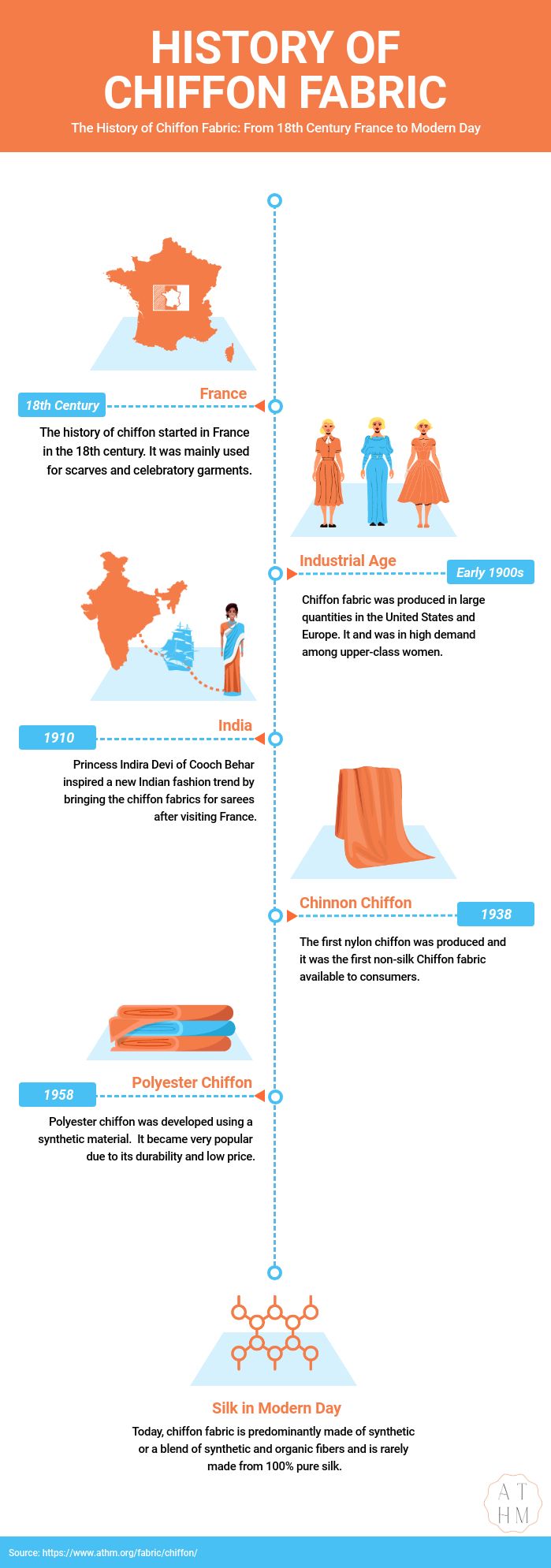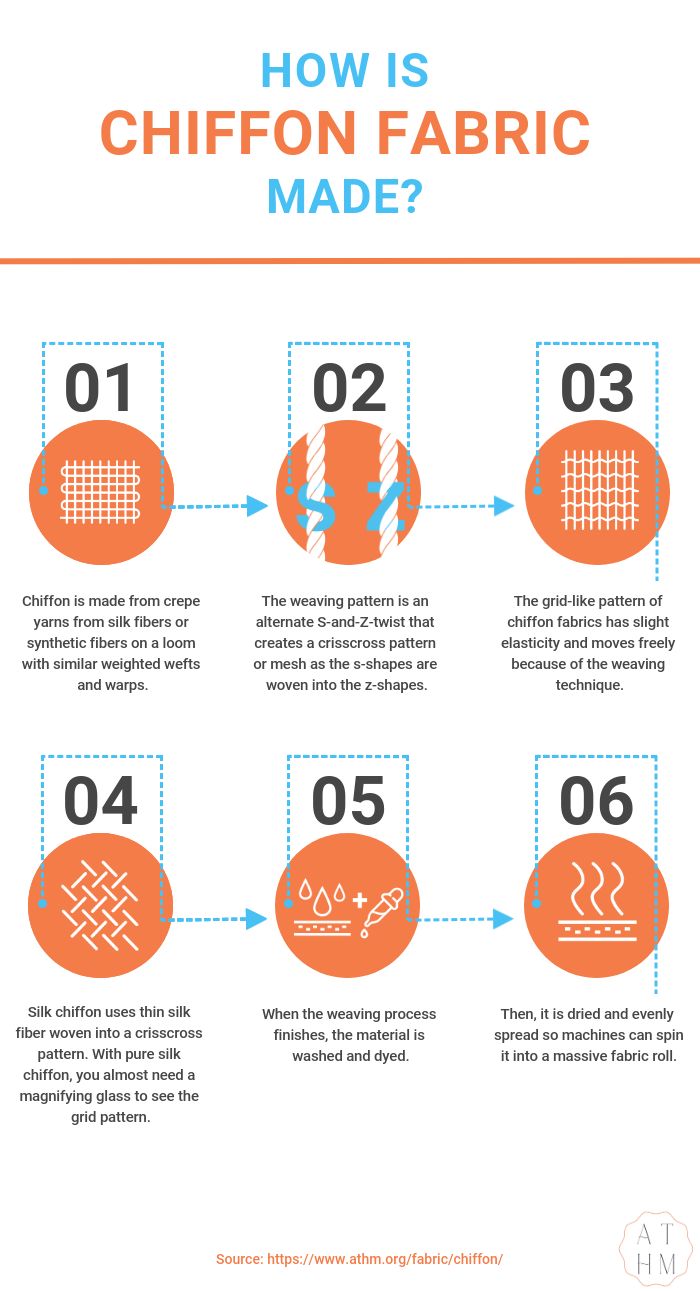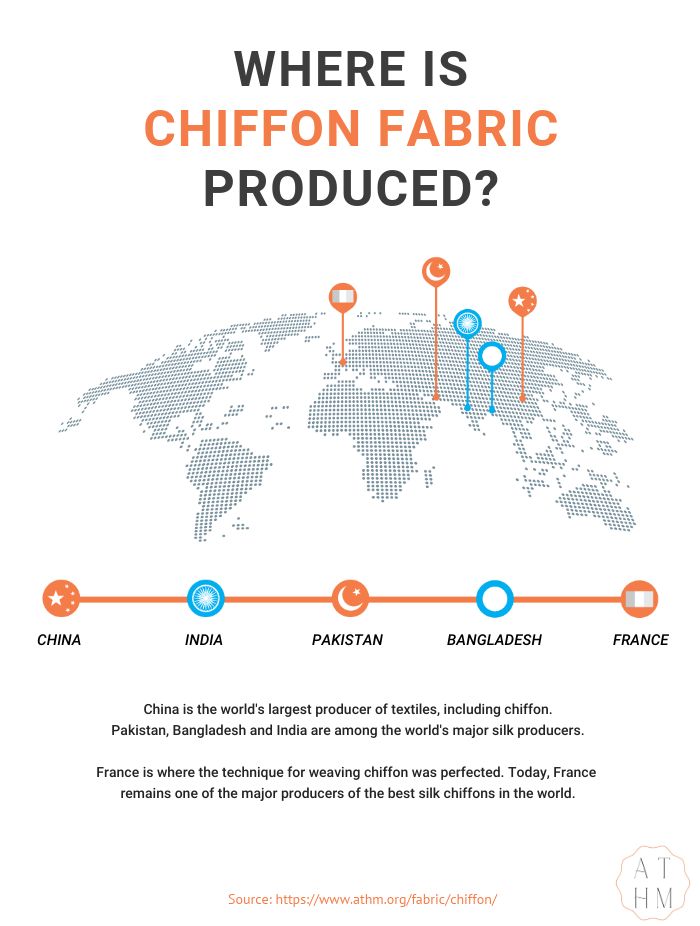Chiffon is a sheer, light fabric made from silk or synthetic materials. It is often used in eveningwear and is known for its floaty, ethereal quality.
Chiffon is commonly used for gowns, dresses, and costumes because it moves with the wearer to highlight every motion, even from a distance. This intricately woven material is made by machine or hand for a distinct lightweight feel and porous surface that adds a slight shimmer to this flowing fabric.
French artisans working with silk fibers first presented this well-known fabric to the world. Once they did, it quickly expanded across the globe as an elegant fabric ideal for hot occasions. Today, you can find chiffon in retail stores across the globe because of innovations in technology and trading routes.
Are you interested in learning more about chiffon? Continue reading for more information about the history of chiffon, what characteristics make this fabric distinct, and why you should add it to your online cart or shopping list.
What is Chiffon Fabric?
Chiffon is a plain-woven fabric traditionally made from silk. Weavers also use cotton or synthetic fibers like polyester, rayon, or nylon to make most chiffon seen today. The material features a woven grid pattern with tiny spaces between the threads, giving this fabric a sheer appearance and featherlike movements.
This see-through fabric is known for its elegant draping effect. This material is flowy, lightweight, and has a wide variety of color options.
Chiffon is a versatile fabric commonly used in clothing, from scarves to wedding gowns. Chiffon is also featured in home decor like curtains, furniture upholstery, and accessories.
History of Chiffon Fabric

The written history of chiffon began around the 18th century in France and was predominantly used for scarves and celebratory garments. Since chiffon was made exclusively from raw silk fibers before 1938, all chiffon made before then was a symbol of high status.
Due to the elegance and expense of the sheer fabric, silk chiffon was only affordable to the very wealthy.
The word chiffon originates from the French word chiffe, which means rag or cloth. However, chiffon was not only seen on the royals of France. As silk’s primary producers and traders, China, India, Pakistan, and Bangladesh saw chiffon adorn their wealthiest figures.
Princess Indira Devi of Cooch Behar was a significant figure in popularizing chiffon fabrics for sarees in the 1910s. After visiting France and seeing the silk chiffon material, she returned to India and brought the fashionable fabric. She had all of her sarees custom-made in France and imported to India. She inspired a new Indian fashion trend that persists today.
It wasn’t until 1938 that nylon transformed the textile industry and made chiffon less costly to produce. Twenty years later, in 1958, textile manufacturers started using polyester to reduce costs further and increase the fabric’s durability.
Chiffon is woven on a loom and requires meticulous work. Nowadays, mechanical looms assist with tricky processes and make production more efficient, making chiffon fabric available for the masses at an affordable price.
Today, chiffon fabric is predominantly made of synthetic or a blend of synthetic and organic fibers and is rarely made from 100% pure silk.
Properties and Characteristics of Chiffon
Chiffon stands out from other fabrics because of its unique properties and characteristics like its sheerness, draping effect, and fine net.
Chiffon is a flowy, lightweight, and popular fabric that is easily recognized by qualities like:
- Sheerness
- Texture
- Stretch
- Shimmer
Chiffon is a sheer fabric, which means it’s slightly see-through. Because chiffon is semitransparent, it’s commonly used as an overlay. The S-and-Z-twist weaving pattern creates a series of small square holes in the fabric, which helps make this fabric extremely lightweight. The small holes also create a chiffon’s unique texture.
Silk chiffon has a softer feel than synthetic chiffon. But, because of the crisscross design, when you rub it between your fingers, the grooves in the fibers create friction. Synthetic chiffon can feel like rubbing sandpaper between your hands, especially if handled frequently.
The S-and-Z-twist technique also allows this material to have a slight stretch. The fibers have room to move, creating an elegant flowing look as they shift with movement. For example, chiffon made from synthetic fibers has more elasticity than natural fibers due to additives like elastane.
Chiffon has a slight shimmer that adds to the ethereal look of the draping effect. Just like chiffon’s other characteristics, its shimmer is also due to its weaving pattern.
The material’s grid-like pattern creates visual texture and a texture you can feel. The holes in the fabric create subtle differences in dimension. For example, the fabric has a slight iridescence when light hits the different angles of fibers. This radiance is particularly evident with shimmery fibers like silk but also with synthetic fibers.
Types of Chiffon
What makes chiffon distinctly chiffon is the technique in which you weave it, not the fibers used to produce it. Below are some of the main types of chiffon you’re likely to come across while shopping for this fabric.
Polyester or Rayon Chiffon
Rayon and polyester chiffon are the most common types of chiffon fabric you’ll find while you shop for sewing supplies.
These durable and affordable fibers have revolutionized the production of this fabric. Polyester and rayon chiffon are both affordable options for quality chiffon.
Silk Crepe Chiffon
Silk crepe chiffon uses silk crepe yarn to produce a sheer and lustrous effect. This type of chiffon uses the same S-and-Z-twist technique as polyester chiffon. However, silk chiffon is of higher quality due to the cost of materials and the final look and feel of the product.
Cotton Chiffon
Cotton chiffon uses cotton fiber instead of polyester, rayon, or silk. Cotton chiffon is more eco-friendly than pure synthetic chiffon. However, it has less shimmer than other popularly used fibers.
Chiffon with Lurex
Lurex is a famous brand that makes fibers with a metallic luster. Chiffon with Lurex combines the shimmer of the Lurex metallic thread and the sheerness of the weaving technique for a dramatic iridescent effect.
Jacquard Chiffon
Jacquard Chiffon is essentially embroidered chiffon made on a Jacquard loom. Jacquard chiffon has a pattern woven into the sheer fabric, creating the illusion that the designs are floating.
Double Faced Chiffon
Double-faced chiffon has two layers rather than one sheer layer. Double face chiffon includes an opaque fabric and the light chiffon outer layer, so audiences look at the dress rather than the semitransparent figure underneath.
An example of double-faced chiffon in popular culture is the 2003 film What A Girl Wants. The movie features an iconic scene where Amanda Bynes cuts up her double-faced chiffon dress to reveal the sleek, silky gown underneath.
Chameleon Chiffon
Chameleon chiffon is a type of chiffon with an ombré color pattern. Chameleon chiffon effortlessly transitions from one color to the next, just like the animal it was named after. While you won’t change color while wearing this fabric, it creates a dynamic story from the base to the top of the garment, drape, or tapestry.
Pearl Chiffon
Pearl chiffon is a slightly coarser, less translucent version of chiffon fabric. Before the fabric is dyed, it resembles cheesecloth. Pearl chiffon still has some transparency but is typically less sheer than traditional chiffon.
Pearl chiffon is a popular material to use for fashionable hijabs. Pearl chiffon is less see-through than traditional chiffon yet still boasts advantages like lightweight and breathable features.
How Is Chiffon Fabric Made?

Chiffon is made from crepe yarns from silk fibers or synthetic fibers on a loom with similar weighted wefts and warps.
The weaving pattern is an alternate S-and-Z-twist that creates a crisscross pattern or mesh as the s-shapes are woven into the z-shapes.
The grid-like pattern of chiffon fabrics has slight elasticity and moves freely because of the weaving technique. This slight stretch is why chiffon has the draping effect it’s renowned for.
Silk chiffon uses thin silk fiber woven into a crisscross pattern. With pure silk chiffon, you almost need a magnifying glass to see the grid pattern. Synthetic chiffons have a more obvious crisscross weaving pattern.
When the weaving process finishes, the material is washed and dyed. Then, it is dried and evenly spread so machines can spin it into a massive fabric roll.
How Is Chiffon Used?
Chiffon is used for clothing, furniture, home decor, accessories, and drapery. This elegant fabric is versatile and observable in high fashion settings as much as inside accessible retail stores.
The fashion industry has embraced chiffon since the 1700s, with the first use of chiffon fabric being used to produce royal scarves. Since the 1900s, production processes have made the material more available for this textile to be used in brightly colored blouses, evening wear, wedding dresses, and lingerie.
Chiffon is not a conventional material for wedding veils. However, current fashion trends have made it an increasingly popular fabric to choose from instead of tulle as a unique veil on your big day.
Chiffon is sheer and lightweight, so it is a popular fabric to use in costumes that seek to accentuate movements without hindering the wearers’ movement.
You’ll spot chiffon at red carpet events on the gowns of celebrities or as flowing backdrops decorating the event space.
Chiffon fabric is renowned for its draping effect, making chiffon an obvious choice for drapes and interior decorating. Because of the chiffon’s translucency, sunlight flows through the sheer curtains, illuminating spaces while still creating a thin veil of privacy.
This flowy fabric is also a popular choice for accessories. For example, you can easily spot chiffon bows on purses, headbands and hairpieces, and chiffon shawls or wraps at any retail store.
Advantages of Chiffon
There are many advantages to using chiffon for clothing, drapery, and decorating. It’s a versatile fabric that can easily enhance the look of a space or an outfit.
Drapes Beautifully
One of the most visible qualities of chiffon is how it drapes. When used for gowns, it creates a soft rustling movement that makes the wearer look like they’re gliding.
High fashion utilizes the draping effect chiffon has since it captures the motion of a model for an unmissable catwalk performance.
The draping effect of chiffon is caused by the weave design. The mesh-like fabric can move, almost like microscopic and much lighter chainmail.
Because chiffon is so striking when it’s hanging, this textile is ideal for window curtains, statement walls, and backdrops. You can drape chiffon fabric as a flowing table runner that drapes beautifully down the sides.
Lightweight and Breathable
Chiffon is an extremely breathable and lightweight fabric. Not only does this material look alluring as a dress or saree, but its breathability makes it perfect for summer weddings.
Chiffon is commonly used in athletic costumes because of its lightweight quality. Dancers, gymnasts, and skaters can move freely as the fabric rises and falls with their movements for a dramatic effect that can win them the gold.
Versatile
Chiffon is a versatile fabric that can be used for embroidery, furniture, or clothing.
You can buy chiffon in virtually any color because it is easily dyed and widely produced. This is one of the fabrics that you likely won’t need to custom order from the manufacturer.
You can create something beautiful out of chiffon fabric no matter the size swatch you have on hand. Once chiffon was exclusively for royalty, but today the sheer fabric can be used in DIY projects in your home or closet.
Affordable
One of the biggest advantages of using chiffon is its affordable price. Once made of silk, chiffon is now affordable to the masses.
Chiffon has a history of luxury even though the current cost no longer reflects that. However, it is still perceived as an elegant fabric that effortlessly upgrades a look.
Disadvantages of Chiffon
Chiffon is a lovely fabric to look at in a home or on a clothing rack, but there are disadvantages to using this material that one must consider when shopping for the best fabrics.
Challenging to Sew
The sewing process with chiffon is not as straightforward as other textiles. Chiffon is slippery and can bunch and creep easily when making apparel or home furnishing. Because chiffon is slippery, it’s notoriously hard to cut out.
Placing pins and paper between the fabric provides more grip, which will significantly help reduce creeping and the fabric slipping while you’re working with it.
Frays and Damages Easily
If you’ve ever worn chiffon before, you know that a single snag can ruin the entire outfit. Chiffon frays easily because the fabric is woven in a grid pattern. Once a single thread is pulled or damaged, it bunches and frays the connecting fibers.
You’re unlikely to mend damaged chiffon, which contributes to this fabric not being considered an eco-friendly choice.
Not Eco-friendly
Chiffon is not an eco-friendly material because it typically has synthetic fibers that are non-biodegradable and require chemicals to manufacture. Non-biodegradable fibers used in clothing that damage easily is how our landfills are full of discarded clothing.
Pure silk chiffon is a more eco-conscious option because it is a natural fiber that is biodegradable. However, silk is not vegan. Silk is produced from silkworms and is considered an animal byproduct. The use of animal products is a disadvantage of pure silk chiffon because those following a vegan lifestyle will boycott this fabric.
Alternatives to Chiffon
Since chiffon can be a challenge to sew and may cause reservations for eco-conscious fashion designers and home renovators, these are some alternatives to chiffon that might suit you better.
Silk Organza
Silk organza is similar to chiffon because it is a thin, plain-weave fabric with a translucent finished appearance. However, silk organza operates uniquely than chiffon in how it drapes and falls.
Silk organza has larger and more dramatic drapes because the fabric is slightly more rigid. This rigidity makes silk organza fall less rapidly than chiffon, which creates a stunning effect that almost levitates the fabric as the wearer moves.
Tulle
Tulle is similar to chiffon because it is a fine mesh fabric. Tulle is well-known as the fabric that hugs ballerinas as they dance on stage. Tulle is more rigid and rough than silk organza and chiffon.
Tulle is typically used for wedding veils because the holes between the fabric are slightly larger than chiffon. However, chiffon is seen more and more as a fabric suitable for veils.
Nylon Net Fabric
Nylon net is a mesh fabric most commonly seen in mosquito nets. Nylon net fabric has more of a honeycomb design than the grid design that chiffon has but can be used as a chiffon alternative for decorative backdrops or apparel.
Georgette
Georgette is a more opaque version of chiffon that’s better suited for blouses because it’s less see-through. Georgette is duller than chiffon because its opaque quality disallows for the dimensions in the fabric to be seen through the folds.
Georgette is similar to pearl chiffon but has less of a shimmer and more of a solid color and texture.
Where Is Chiffon Produced

China is the world’s largest producer of textiles, including chiffon. Pakistan, Bangladesh, and India are some of the world’s largest producers of silk. These countries typically export the raw silk to countries with more means of production, like China.
France is where the technique for weaving chiffon was perfected. Today, France remains one of the major producers of the best silk chiffons in the world.
How Much Does Chiffon Cost?
The price for chiffon fabrics differs based on the fibers used in manufacturing. Synthetic chiffon, like polyester, has a price tag of around 2$ to 3$ per yard. Pure silk chiffon ranges from 15$ to hundreds of dollars per yard.
Making chiffon is a slow and laborious process regardless if it’s woven by hand or machine. However, handmade chiffon silk chiffon is the most costly of chiffons to purchase.
What Certifications are available for Chiffon?
Looking for certifications on chiffon fabrics is one way to ensure that the chiffon you are purchasing is made with mindfulness.
The GREENGUARD Certification lets you know that the textile was made with the lowest amount of emissions and harmful chemicals possible.
Since 1938, chiffon fabric began using synthetic fibers in production, making the majority of modern chiffon textiles ineligible for eco-friendly certifications from the Global Organic Textile Standard (GOTS) or Global Recycled Standard (GRS).
If you’re shopping for silk chiffon, then look for the Silk Mark certification either sewn into the garment or included in the packaging. The Silk Mark certification lets you know that the silk used in manufacturing follows ethical and environmental standards for the people handling the materials and the 100% pure silk materials used.
How To Tell High-quality Chiffon From Low-quality Chiffon
High-quality chiffon is made from silk fibers rather than synthetic ones. Silk is a strong, thin fiber that is costly to produce since silkworms produce the raw material.
You can easily tell if you have silk chiffon vs. polyester or nylon chiffon by examining the material. Synthetic chiffon has a coarser and more visible weave that, when rubbed against itself, has a rough feel similar to sandpaper.
What is the Environmental Impact of Chiffon?
Chiffon made with synthetic fibers like nylon or polyester is not eco-friendly. Nylon and polyester are man-made fibers that need large amounts of energy to produce. Because synthetic fibers are made from non-biodegradable materials that use harsh chemicals in production, garments featuring these ingredients contribute to pollution.
Chiffon made from natural fibers like silk or cotton is biodegradable but may still use chemicals in the manufacturing process that are harmful to the planet.
Chiffon is renowned for its texture and elegant feel. However, the delicate fabric is easily damaged, making it a material more likely to end up in the trash faster than other more durable fabric types.
